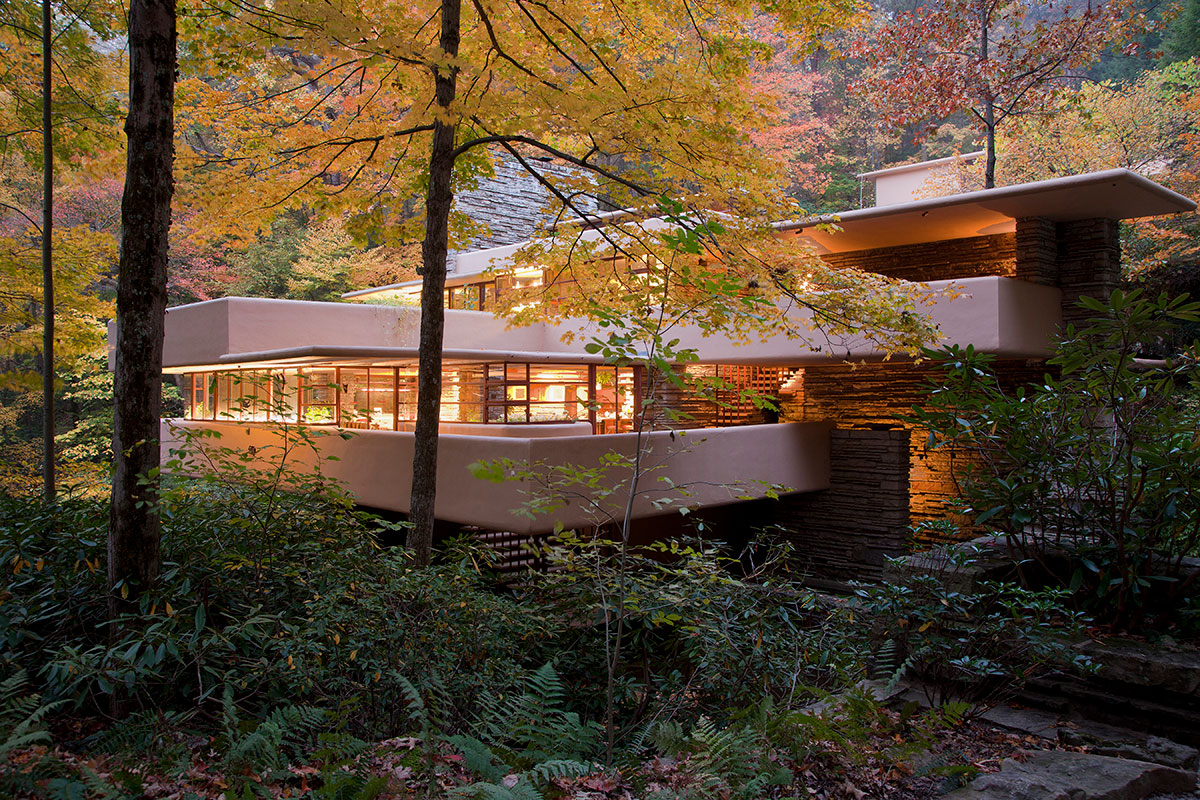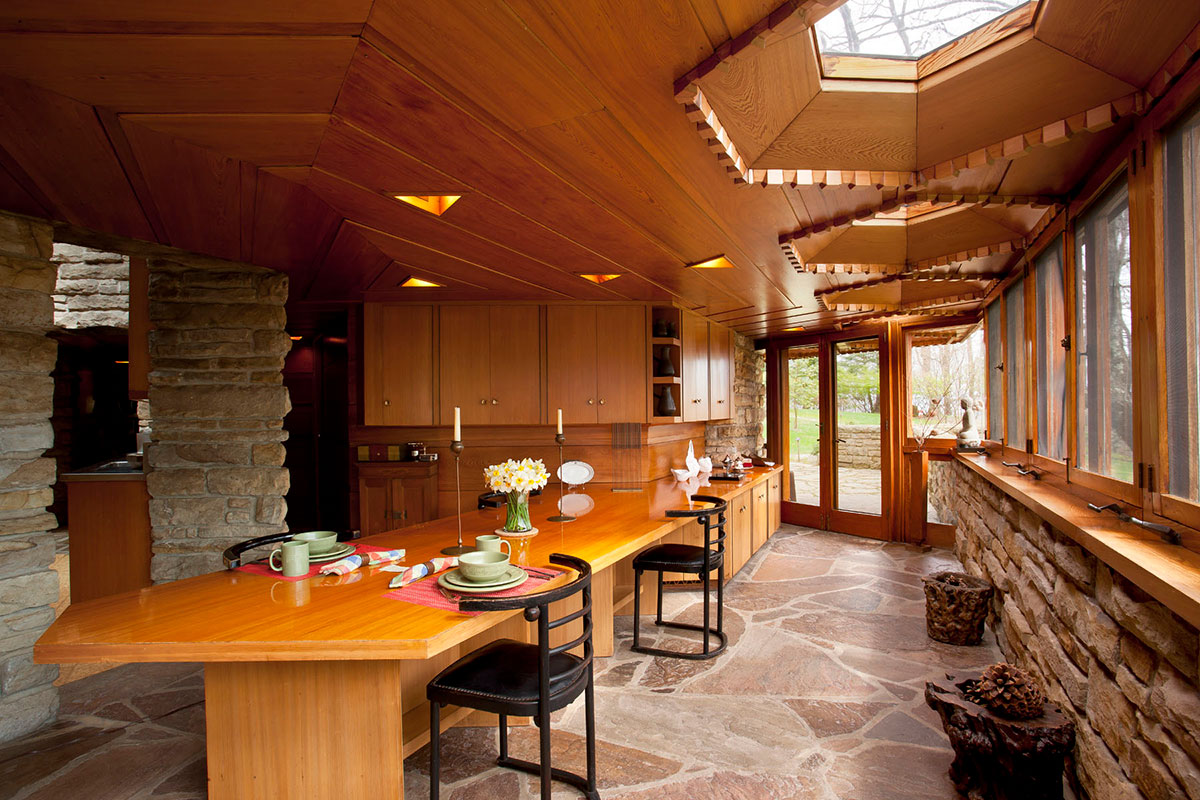This website uses cookies so that we can provide you with the best user experience possible. Cookie information is stored in your browser and performs functions such as recognising you when you return to our website and helping our team to understand which sections of the website you find most interesting and useful.
Explore the ever-growing appeal of Frank Lloyd Wright, America’s master of modern architecture
By Daniel Pembrey | 27 February 2020 | Lifestyle, Travel
In 2019, eight homes designed by the late Frank Lloyd Wright became the first contemporary designs to achieve UNESCO World Heritage status

Initially, Liliane Kaufmann had reservations about Fallingwater, the unique home that architect Frank Lloyd Wright designed for her and business mogul husband Edgar in 1935. The couple owned Kaufmann’s Department Store in Pittsburgh, a byword for metropolitan style in the era, yet this unusual home in rural Pennsylvania – more than an hour’s drive from Pittsburgh – seemed basic inside; austere, even.
Intimations of the building’s future fame came fast. Time magazine put it on its front cover in 1938 and it went on to be named as “the best all-time work of American architecture” by the American Institute of Architects. In 2019, Fallingwater and seven other Wright-designed buildings became the first modern architecture designation on the UNESCO World Heritage List in the United States.
“It is an immense honour to have Frank Lloyd Wright’s work recognised on the world stage among the most vital and important cultural sites on Earth like Taj Mahal in India, the Pyramids of Giza in Egypt and the Statue of Liberty in New York,” said Stuart Graff, president and CEO of the Frank Lloyd Wright Foundation. “It recognises the profound influence of this American architect and his impact on the whole world.”
Wright was born in Wisconsin in 1867, the son of a preacher and musician father and a teacher mother, and was widely travelled in his youth thanks to his father’s ministry positions in Rhode Island, Iowa, Massachusetts and Wisconsin.
Wright would live until 1959, well into the modern era. He set up his architectural studio in Oak Park, Illinois (now open to the public) but travelled far and wide for his work, absorbing influences from pre-Columbian Mexico to ancient Japan. He was a prolific designer. He designed over 1,000 buildings, more than half of which were built. His energy was extraordinary, not only in terms of the number of projects but also in terms of his capacity to think through the smallest details at a time when everything needed to be drawn by hand.
The eight UNESCO listings reflect the breadth and depth of his achievements. Listed alongside Fallingwater – arguably his masterpiece – is his Unity Temple in Oak Park, the Guggenheim Museum in New York City and five homes, including Wright’s own residences at Taliesin in Wisconsin and Taliesin West in Arizona, plus the recently restored Robie House in Chicago. The variety of purpose and styles is matched by the diversity of their settings: city, suburban, forest, and desert environments. These listings recognise his influence on the rest of the world and in particular the European Modern Movement in architecture. >>
Related: This eco-resort has brought a wave of luxury to Brazil's Praia do Forte

By the time Wright designed Fallingwater, aged 68, his ability to synthesise global influences was an art form in itself. The rectilinear patterns, low seating in the living room and the spherical kettle over the fireplace evidence his trips to Japan between 1905 and 1922. Yet the genius of Fallingwater, and the secret of its universal appeal, lies in a unique interpretation of setting – both as a place in the physical landscape and as a point in history.
Standing on the far side of the Bear Run stream, taking in that famous front view of the house, you can’t help marvel at what Wright conjured up here. Fallingwater’s formal purpose as a domestic abode effectively dissolves. The geometric abstraction appears to proceed directly and organically from the rocks.
Yet just as striking is the experience inside the house – one of absolute union with surroundings, specifically that ever-audible waterfall above which the house rests. The interior space is in fact just 2,885 sq ft, increasing to 5,330 sq ft when outdoor terraces are » included. To cantilever these terraces, Wright used the latest concrete technology.
Open yet sheltering, dynamic yet unified: Fallingwater is at heart a paradox, defying easy analysis. By her own admission, the worldly Liliane Kaufmann came to glory in its sense of space and peace, ultimately resenting even the slightest addition to the simplicity of her room with its views of leaf-laden trees or bare interlacing branches depending on the season.
The Kaufmanns’ son, Edgar Jr, donated Fallingwater to the Western Pennsylvania Conservancy in the 1960s, following his father’s wish to share the property with the public. Since it attained World Heritage status, the challenge today is navigating the number of visitors. However, for those determined to have the place to themselves, it is possible to book out all the tickets for a given time and relive Mrs Kaufmann’s experience of peaceful solitude.
There are other options, too, for those keen to deepen their experience here. Just six miles away from Fallingwater lies another Wright home, Kentuck Knob. It is one of his ‘usonian’ houses, a term denoting his more modest dwellings.
They are equally well adapted to the landscape. In this case, the original owners had made their money in the local ice cream trade and, Wright observed, they were ‘perchers’ rather than ‘nesters’. Accordingly, the hexagonally patterned structure is contoured to the crest of a hill, blending in given its use of natural materials – predominantly wood and stone. >>
Related: How the sustainability trend is inspiring HNWs to breathe new life into heirloom furniture

Kentuck Knob exemplifies his principle of blending the exterior of his designs with natural surroundings: “No house should ever be on a hill or on anything. It should be of the hill. Belonging to it. Hill and house should live together each the happier for the other.”
Since 1986, Kentuck Knob has been owned by Britain’s Lord Peter Palumbo – a property developer and art collector. He recounts visiting Fallingwater and noting a chance remark by a guide there, which led him to visit the other house, and purchase it a mere six weeks later.
“I went, I saw, I was conquered – at least by the exterior,” wrote Baron Palumbo in his foreword to Donald Hoffman’s 2000 book Frank Lloyd Wright’s House on Kentuck Knob. “A second visit was therefore essential… My ardor burned bright as ever – brighter still, in fact, when the interior of the house not only met, but exceeded, my expectations. And, thus, the purchase was made.”
Kentuck Knob very much feels like a private home today, albeit one with remarkable personal items: a photograph of Palumbo with Princess Diana, and sculptures by Sir Anthony Caro and Andy Goldsworthy in the grounds.
And so, in the hands of new custodians, these Wright buildings remain living entities. Says MaryAnn Perkins, operations manager at Kentuck Knob: “It’s increasingly popular for discerning visitors to fly in for a private tour and enjoy a fine bottle of wine on a quiet evening – or indeed some local ice cream, of the kind that the original owners made their money from. It lets people experience these places in the way they were intended to be experienced.”







